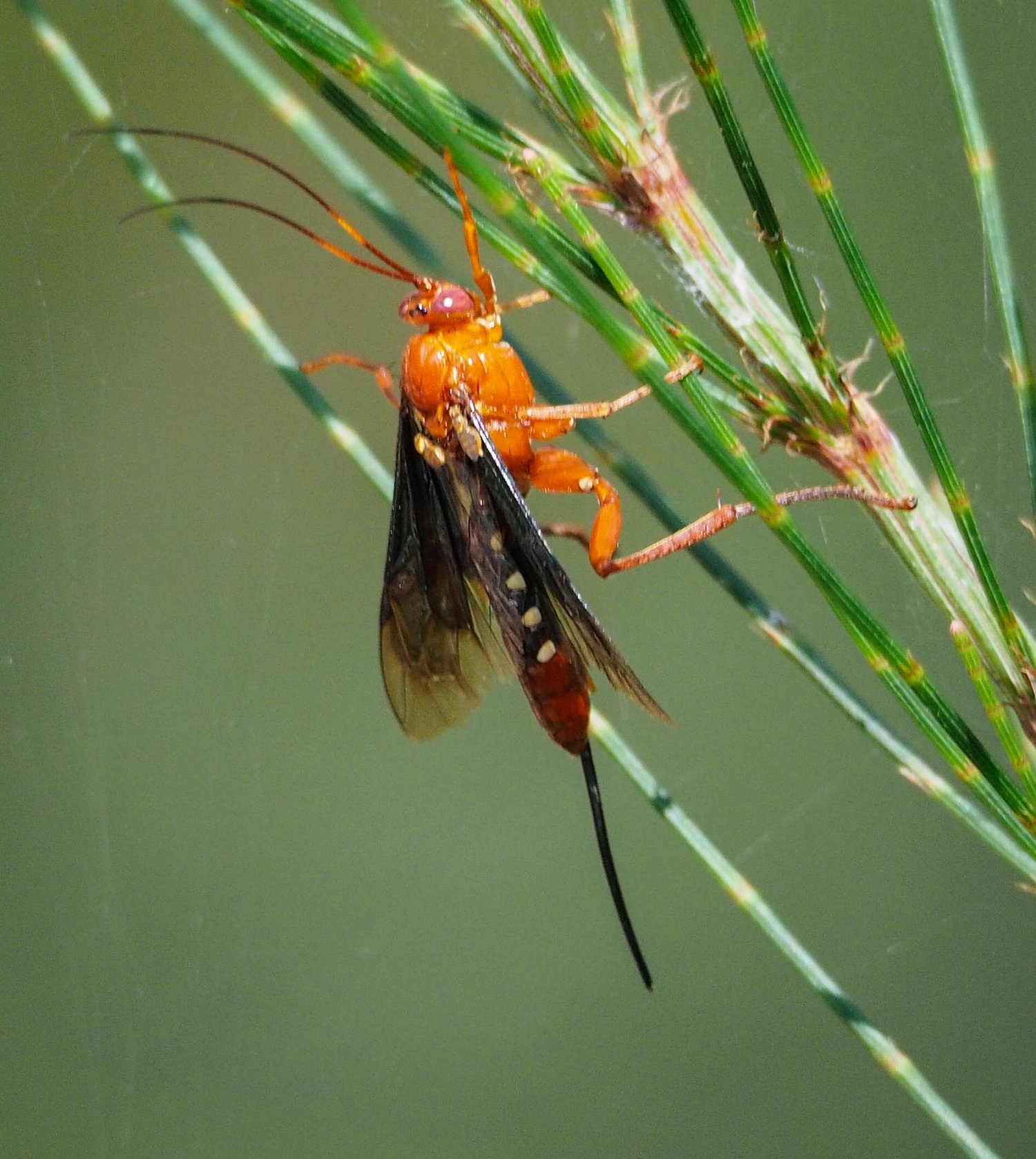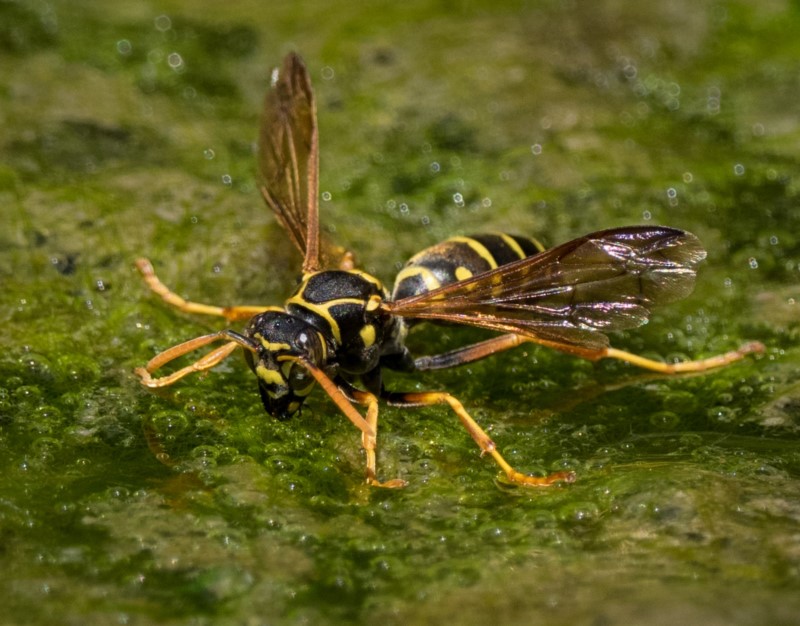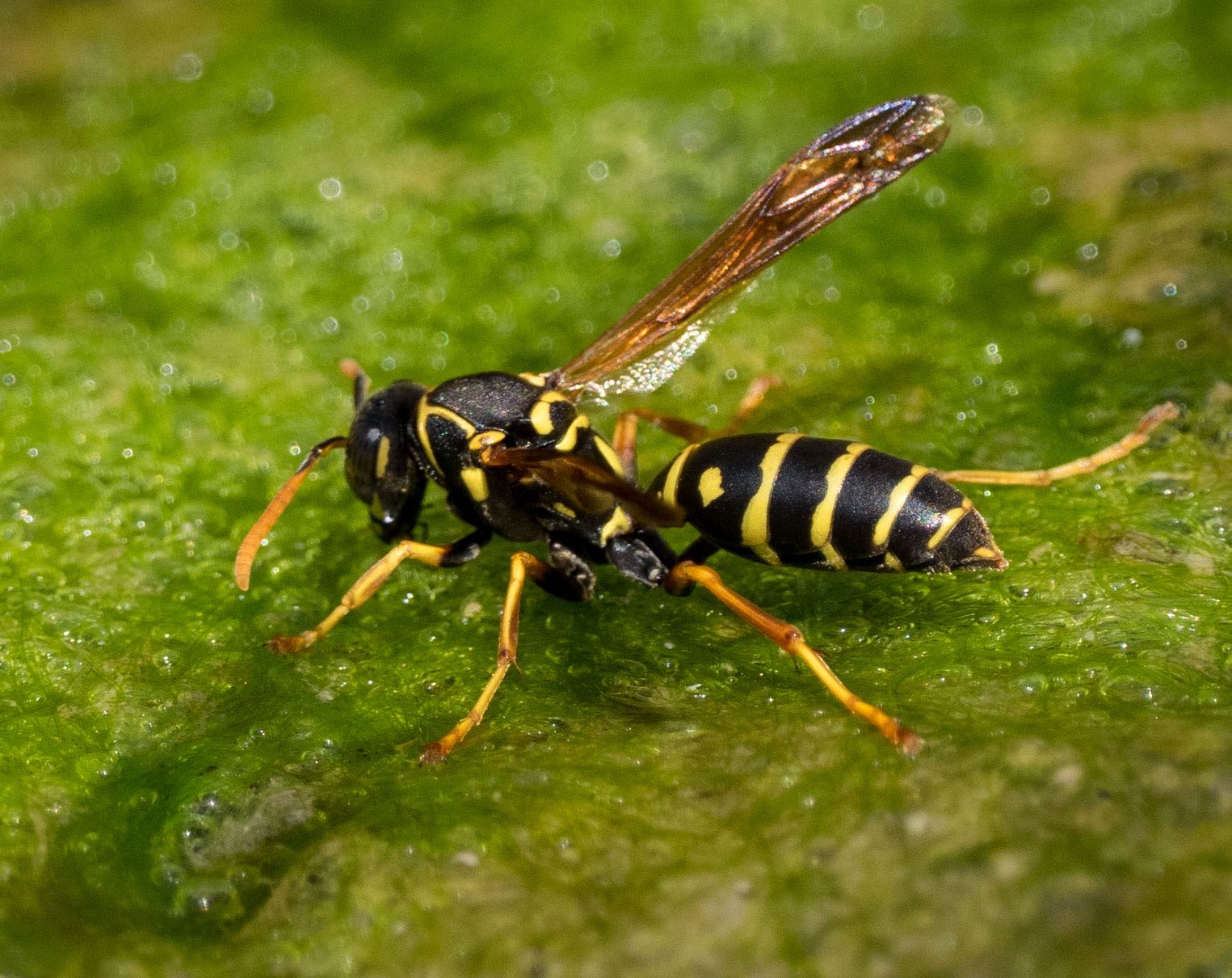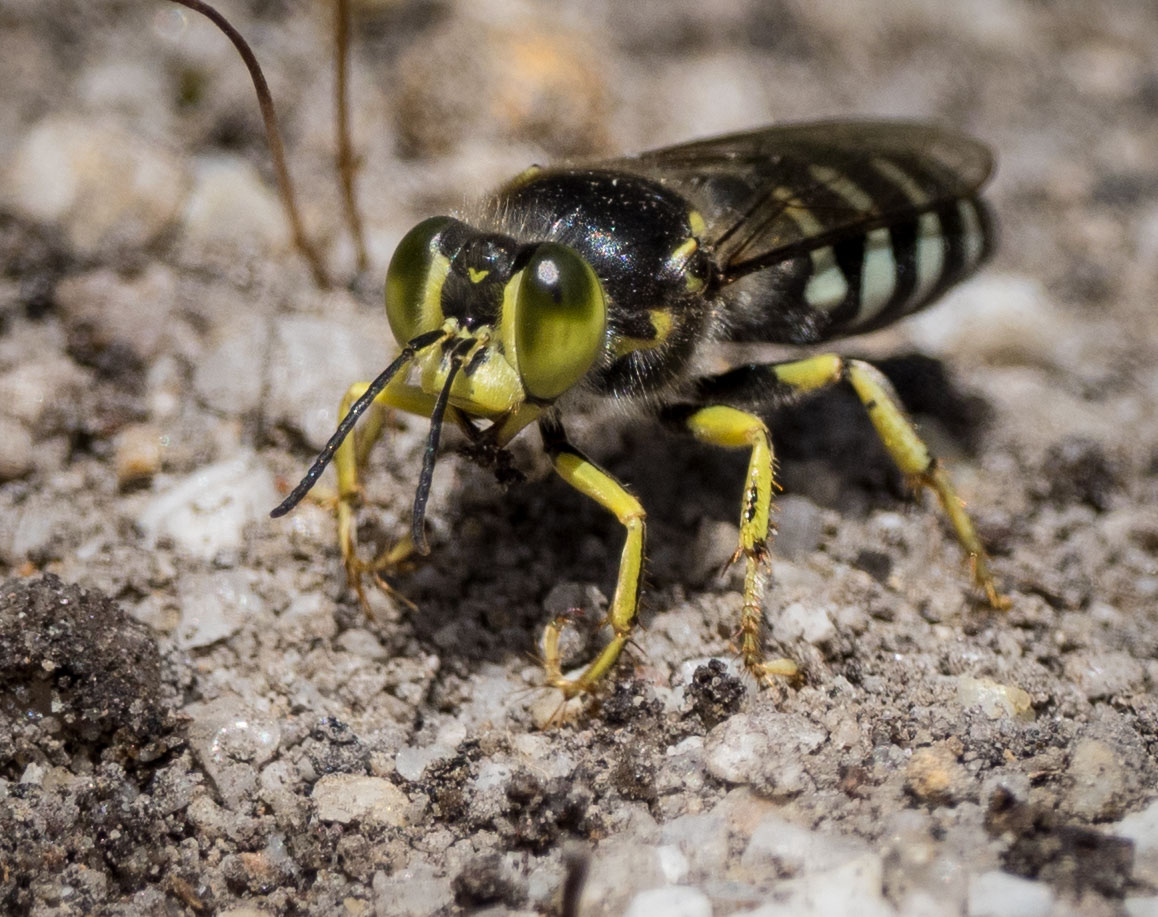Know your wasps
Special Project
There are thousands of species of native wasps in Australia – and the far south coast of NSW is home to many of them.
Wasps play a critical role in the environment. The adults feed on nectar and therefore help in plant pollination. Indeed, some wasps are essential partners for native orchids. Equally important are their roles as predators and parasites. Wasp larvae eat spiders, caterpillars, beetle grubs, and many other insects.
Introduced pest species: not many, and well worth recognising
Unfortunately, we also have a couple of introduced species. One in particular is responsible for giving wasps a rather bad reputation. The European Wasp (Vespula germanica) is that aggressive wasp that hangs about the barbecue and can form huge colonies. It is a serious pest. (see Vic Health for a good overview)
There is another introduced pest that is very similar in appearance and behaviour to Vespula germanica. The ‘Common Wasp’ (Vespula vulgaris) differs in the face markings, so a head shot is necessary in order to confidently distinguish the two species. This page from New Zealand provides an excellent comparison of the two.
European Wasp (Vespula germanica) is an aggressive wasp that forms large colonies. It is native to Europe but is now a major pest in many other countries, including Australia.
(Family: Vespidae; subfamily: Vespinae)
There is also a more recent arrival. The Asian Paper Wasp (Polistes chinensis) is less aggressive than the European Wasp, but it has the potential to disrupt the natural balance between our native wasps and local ecology. So we are all on ‘Wasp Alert’ for this particular invader.
Some of our native species in more detail
The information below provides some insights into the fascinating lives of our local, native species. This is just a small sample. There are hundreds - probably thousands! - of species in our region, each with a particular biology and each playing a particular role in the ecosystem.
1: Sand Wasps
In Summer, sandy paths are often abuzz with these striped wasps. The adults are mating and the females busily building nest burrows and tending to their growing larvae.
Carrying a fly to feed her larva
Bembix sp. (Family: Crabronidae; subfamily: Bembicinae)
Sand Wasps …
… are solitary wasps. That is, each female cares for her own young, in her own burrow. They often build their burrows close to other wasps, in the sandy version of a wasp city.
… feed their larvae on flies. The adults are excellent fliers and can catch their prey on the wing. Of course, only females hunt. They are the sole providers for their developing offspring.
Sand Wasps…
… continuously deliver ‘fresh’ flies to each growing larva. They usually cover the entrance when they leave, and dig it open again upon their return.
Digging open the door to deliver the next meal
Bembix sp. (Family: Crabronidae; subfamily: Bembicinae)
Front legs specialised for burrowing
Bembix sp. (Family: Crabronidae; subfamily: Bembicinae)
Sand wasps …
… are vegetarians as adults. Both males and females feed on nectar and pollen. They’re only carnivorous as larvae.
… live only a short time as adults. In the few weeks of their breeding lives, the female will have just a few young.
… spend most of their lives underground, as larvae then pupae, emerging as adults in Summer.
2: Flower Wasps
Wingless female flower wasps capture attention and are often photographed. They might be seen clinging to the top of a grass blade, waiting to attract a male. Or, perhaps more commonly, they’re seen as part of a curious insect coupling.
Female Flower Wasp, waiting for a male to be drawn by the pheromones she releases.
(Family: Tiphiidae)
Flower wasps …
… are solitary wasps.
… lay their eggs on living beetle grubs, underground. The larvae feed on the paralysed grub, eventually killing it.
… emerge from the ground in Summer, as adults. Males are winged, females rarely so.
Flower wasps …
… feed on nectar, as adults.
Many species play a role in plant pollination, including several species that are important pollinators of native orchids.
… have an extended coupling, during which time the male carries the female to flowers. He even feeds her directly!
… may be brightly coloured. Some species are quite large.
Male wasp feeding the flightless female
(Family: Tiphiidae)
3. Spider Wasps
Often large, with long, spiny back legs, these wasps are specialised spider predators. They are commonly seen poking around vegetation or dragging a de-legged spider across the ground.
Spider Wasps …
… are solitary wasps.
… are specialists, with each Spider Wasp species specialising on a particular group of spiders.
… spend a lot of time walking, seeking hidden spiders.
The beautiful Orange-collared Spider Wasp, Ferreola handschini
(Family: Pompididae)
The wasp has cut the legs of this Wolf Spider for easier transport.
Family: Pompilidae)
Spider Wasps …
… paralyse the spider and either build a burrow nearby, or drag the spider to an existing burrow.
… place a single egg with each paralysed spider, then they close the chamber. After that, the larva is on its own.
4: Parasitic Wasps
There are two large families of very waspy-looking wasps that are commonly called ‘parasitic wasps’. These are Ichneumonidae and Braconidae. Many are tiny, but some are large and brightly coloured. Whereas most other wasps are predators, the hosts of parasitic wasp larvae go on living and feeding … at least for a while.
Parasitic wasps …
… are solitary wasps.
… do not have a stinger! The females often have a very long spike that looks like a stinger, but it is only used for laying eggs. It doesn’t produce venom.
A female brachonid wasp with her extremely long ovipositor.
(Calibracon sp. Family: Braconidae)
These large and colourful wasps are often attracted to lights. They parasitise the larvae of large moths.
(Family: Ichneumonidae)
Parasitic wasps …
… usually lay their eggs inside the living host. Very often the hosts are the larval stages of other insects, such as caterpillars or beetle grubs.
… are vegetarian as adults, feeding on nectar and pollen.
5: Mud-dauber Wasps
A buzzing, vibrating sound coming from a gap in the wall, a window frame or a keyhole draws attention to these industrious wasps. They carry in load after load of wet soil and carefully build a series of enclosed mud cells. The mud-dauber wasp works alone on this impressive construction, taking breaks only long enough to progressively fill each completed cell with an egg and a cache of food.
Mud-dauber wasps …
… are solitary wasps.
… provide each larva with a single, paralysed spider.
Delivering another load of mud to the growing nest.
(Pison sp. Family: Crabronidae; subfamily Crabroninae)
Setting another mud layer in place, like soft clay bricks in a wall.
(Pison sp. Family: Crabronidae; subfamily Crabroninae)
Mud-dauber wasps …
… create multi-celled nests. After a spider is positioned and an egg laid, the female then closes the cell with a cement-like wall. Then she starts on the next cell.
… take advantage of existing crevices, walling them in with mud.
6: Paper Wasps
Social species are in the minority, yet they are the wasps people are most familiar with. Paper wasp nests are often found hanging under building eaves or in low garden shrubs. And if a person tries to knock it down with a broom, there’s a very good chance they’ll be stung. Although not highly aggressive, these wasps will attack if they think their nest is under threat. Left alone, however, they can be considered an asset in the vegetable garden as they feast upon caterpillars.
This native species is a common sight in Summer.
(Polistes humilis Family: Vespidae; subfamily: Polistinae)
Paper wasps …
… are social wasps. There is one ‘queen’, plus many female workers.
… defend their nests by stinging the attacker. The sting registers highly on the pain index!
… are much less aggressive than the introduced European Wasps.
Paper wasps …
… build a multi-celled nest from plant fibres and saliva (= paper).
… collect caterpillars, which they mash up before feeding the mix to the larvae.
… continuously feed the growing larvae, capping cells only when the occupant is ready to pupate.
Worker wasps regurgitate caterpillar mush to each growing larva.
(Polistes humilis Family: Vespidae; subfamily: Polistinae)
Workers resting on top of the nest are on guard against threats from above or below.
(Polistes humilis Family: Vespidae; subfamily: Polistinae)
Paper wasps …
… are nectar feeders as adults, and so may play a role in pollination.
… have colonies that swell over Summer, but apparently disappear in Winter. The youngest, mated females hibernate, emerging in Spring ready to found a new colony.
More photos, more stories
iNaturalist is an important resource and our preferred tool for recording observations. If you add your own sightings you will be helping to build this record of biodiversity, and you’ll get help with the identification from experts and experienced naturalists.
Life in Southern Forest website contains observations and photos of a wide range of local animals … including wasps and other insects.
Written by Kerri-Lee Harris, 15th August, 2019 (updated 31st Aug, 2019).
All photos were taken by the author, and all of the native species were photographed in Wonboyn, NSW.























